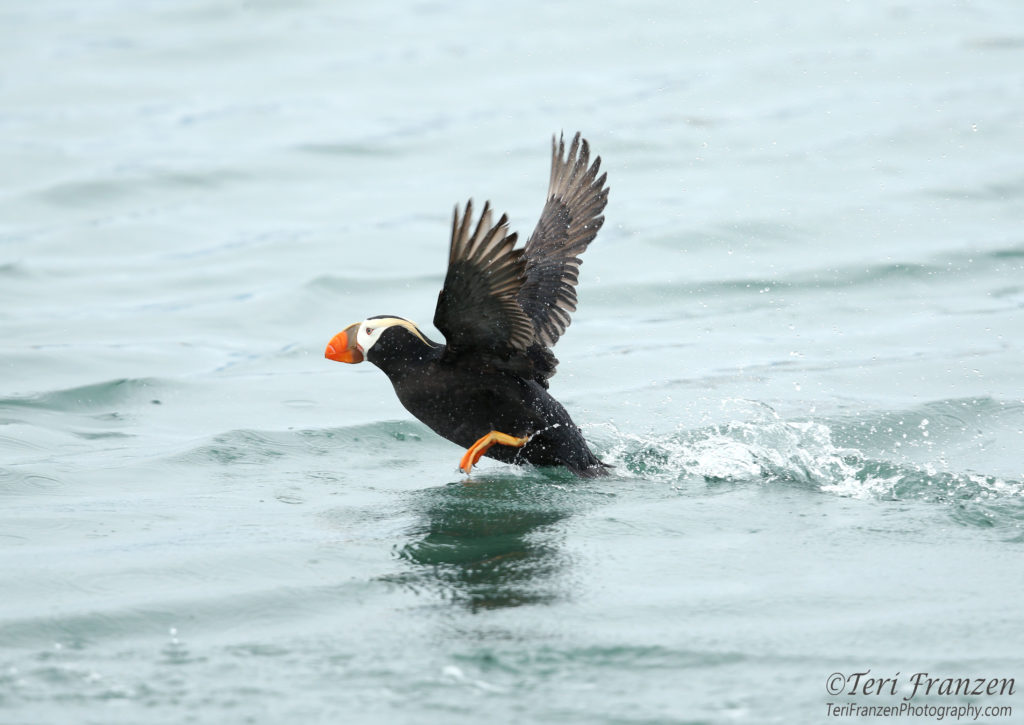“A man has not seen a thing who has not felt it.” – Henry David Thoreau
South Marble Island is a remote limestone outcrop within Glacier Bay, Alaska that has been deglaciated for less than 200 years. In that relatively short time the island has become a critical habitat for a variety of seabirds and mammals. It is a haul-out location for a large number of Steller Sea Lions. And it is a site for multiple nesting colonies, including a few bird species that are endangered. Pigeon Guillemots, Pelagic Cormorants, Glaucous-winged Gulls, Black-legged Kittiwakes, Tufted Puffins and Black Oystercatchers are just a few of the birds that can be found on and around the island. This is an introduction to just a few of those species as well as life on the island.

South Marble Island
Because Sea Lions are federally protected and to reduce seabird disturbance during breeding, South Marble Island is closed to foot traffic and the shoreline is closed to landings. Boaters are required to stay at least 300 feet from shore. While traveling aboard the Snow Goose in July 2016 we planned to circle the island using two-person kayaks, keeping outside the perimeter guidelines. I was nervous about my back, which had been sore from the previous kayak trips that week. And I wanted an opportunity to photograph the island wildlife using my best equipment. One quick, reactionary shift in the kayak moving my long, heavy lens and I’d be in the water with all of my favorite toys and my kayak buddy. Instead I stayed aboard the Snow Goose while all other passengers departed on their kayaks.

Common Murres, Gulls and Kittiwakes fly overhead the group of kayakers as they paddle around the island
The captain waited for the kayaks to disappear around the island before we motored to a spot 300 feet from shore. Along the way we encountered a pair of Marbled Murrelets. Marbled Murrelets are classified as endangered and recent trends indicate that the species is declining. It was only discovered in 1974 that they nest in coniferous forests in trees at least 200 years in age. Loss of old growth forests due to logging is their greatest threat. Little else is known about their nesting behavior except that they seem to prefer solitude to nesting in colonies.
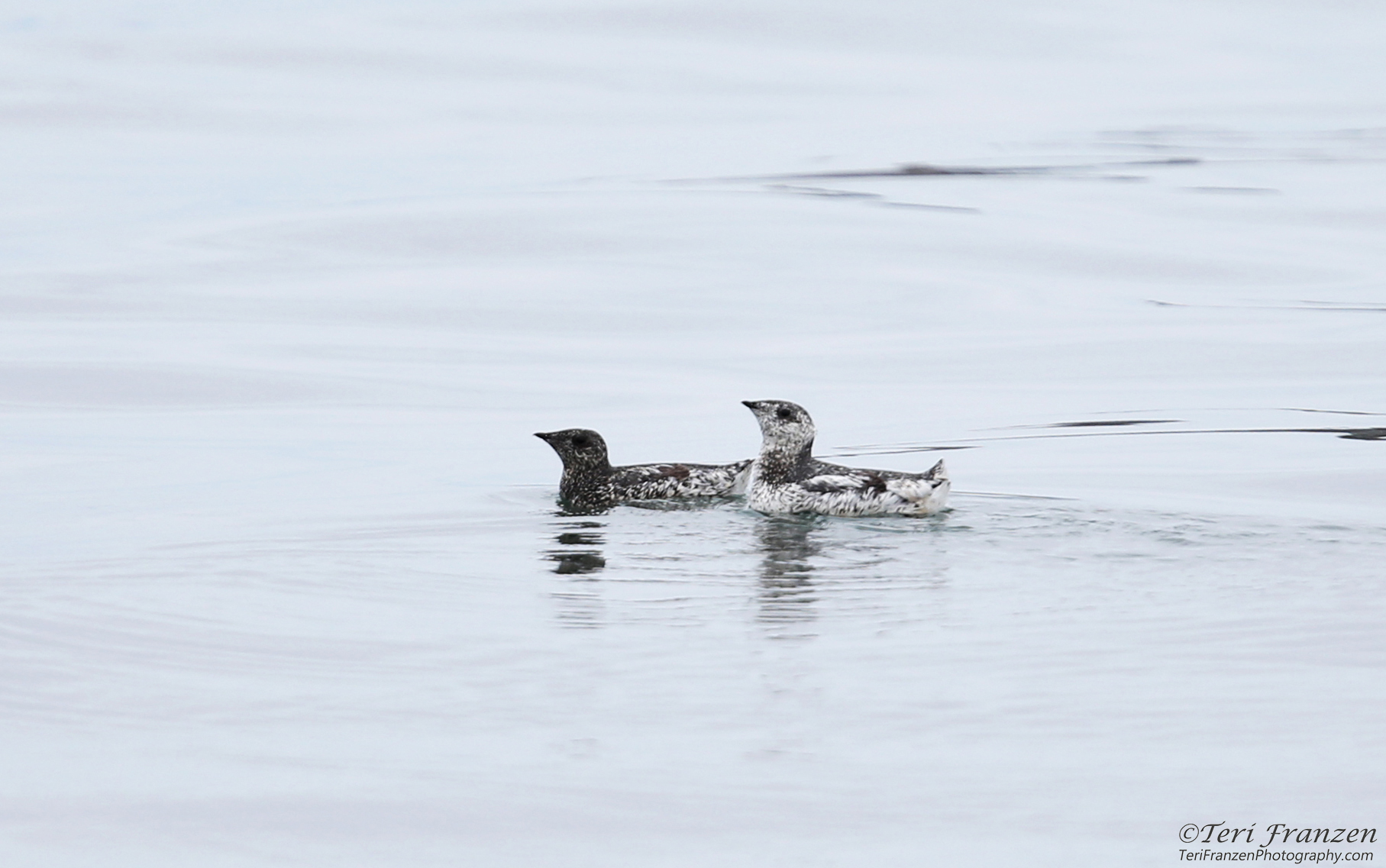
Stocky and tiny, Marbled Murrelets always look proud with their heads held high

In breeding plumage, Marbled Murrelets are brown for camouflage in their nests among tree branches

Marbled Murrelets flap their wings and run across the surface of the water during takeoff
Long before we arrived near the island we heard a loud, low growling accented by the occasional high-pitched bugling, the sounds of Sea Lions. As we crept steadily closer we were hit by the strong, rank stench of dead fish, the smells of a sea lion colony. Upon arrival we were treated to constant activity of sea lions porpoising and climbing to and from the rocks while seabirds filled the sea, sky and landscape. At South Marble Island our senses were overwhelmed.

A Tufted Puffin flies over a rocky outcrop covered with Steller Sea Lions
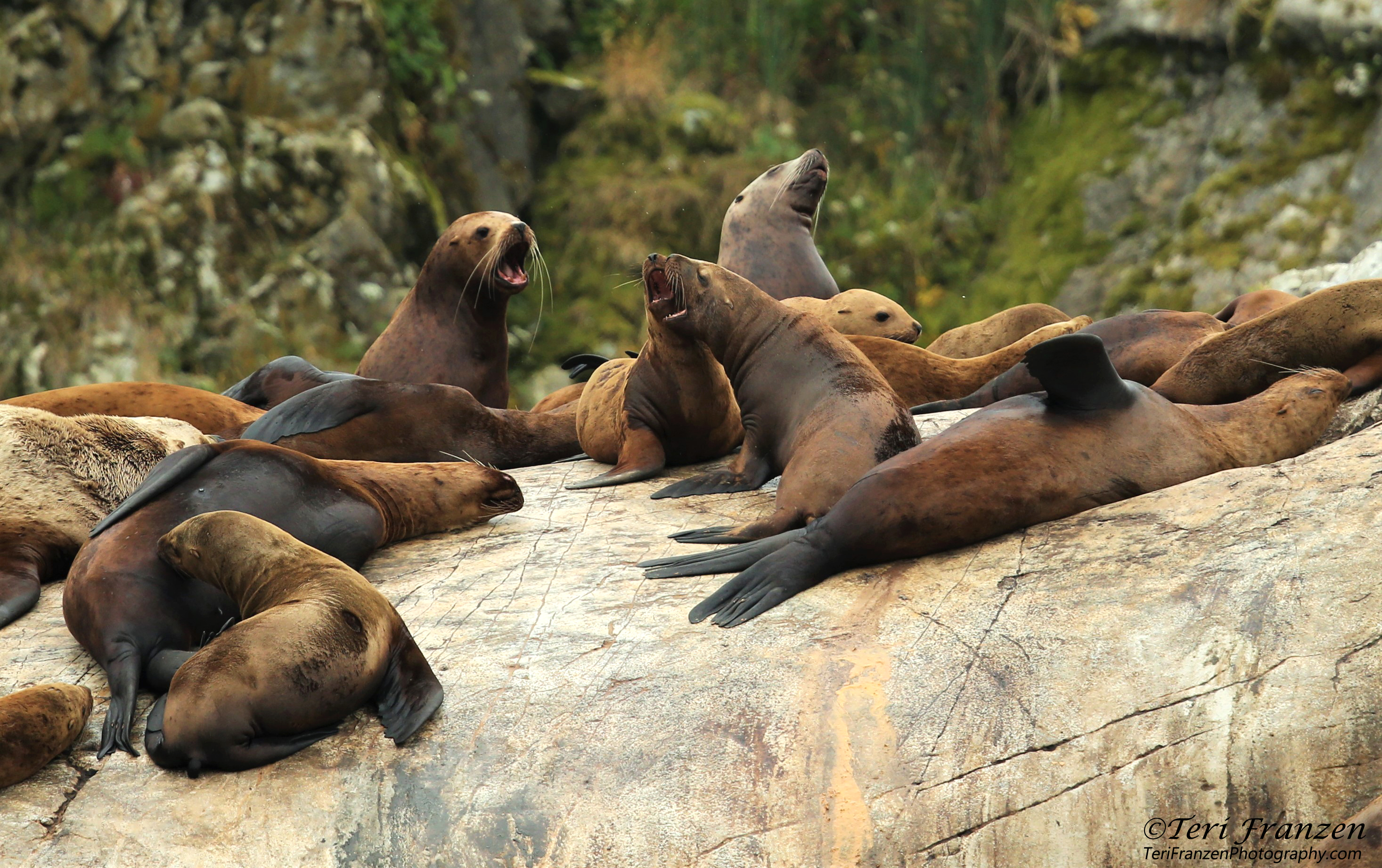
A sea lion pup nurses (bottom left) while the three in the middle appear to engage in a lively debate
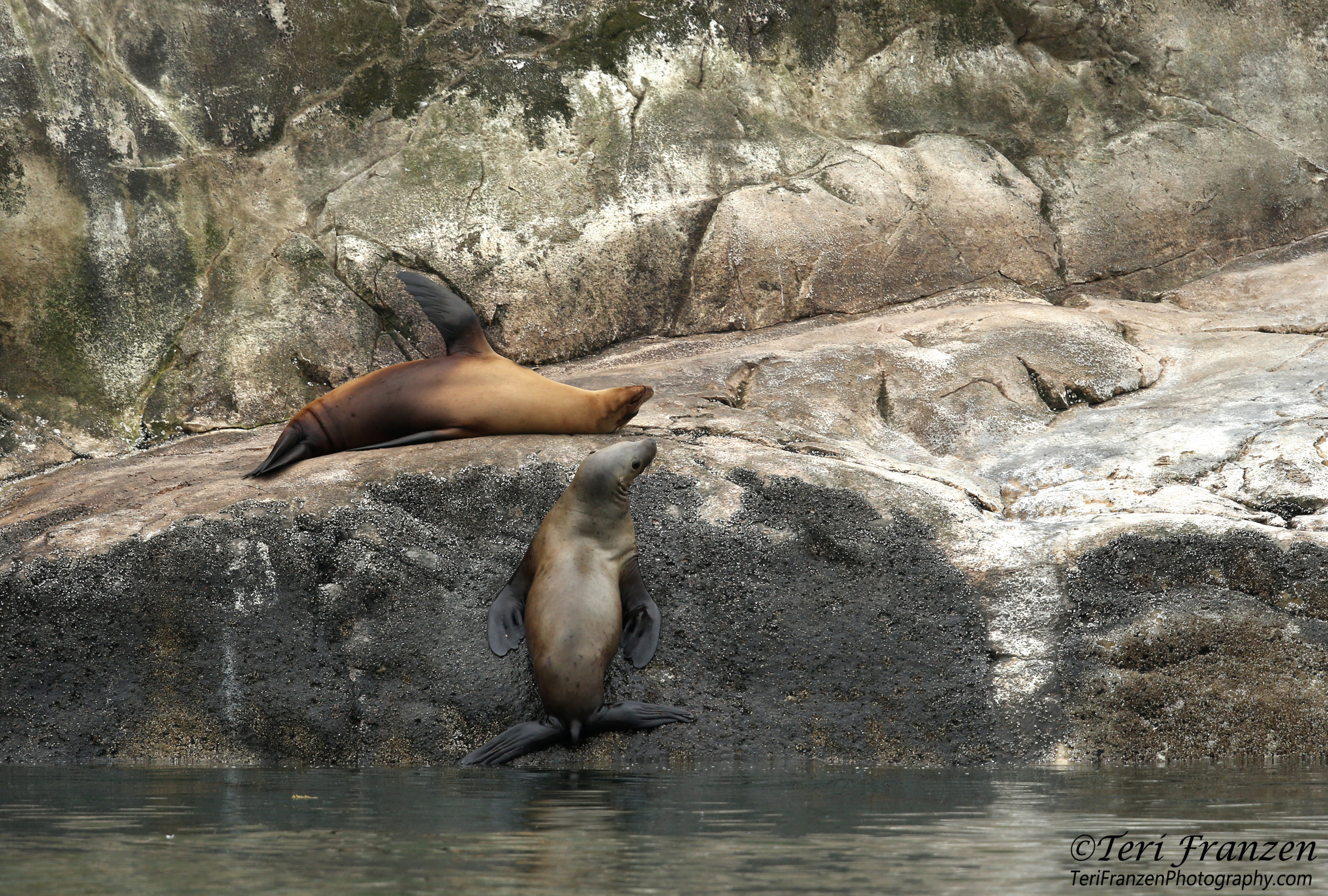
Sea Lions can remain vertically on the rocky surface for several minutes
Stellers are the largest of the Sea Lion species. And they are sexually dimorphic in that bulls can reach significantly larger sizes than females. An adult Steller bull continues to grow for up to eight years and reach lengths nearly 11 feet with a weight approaching 2500 pounds. Although females are not significantly shorter than bulls, at lengths up to 9.5 feet, they are more slender and weigh less than 800 pounds.
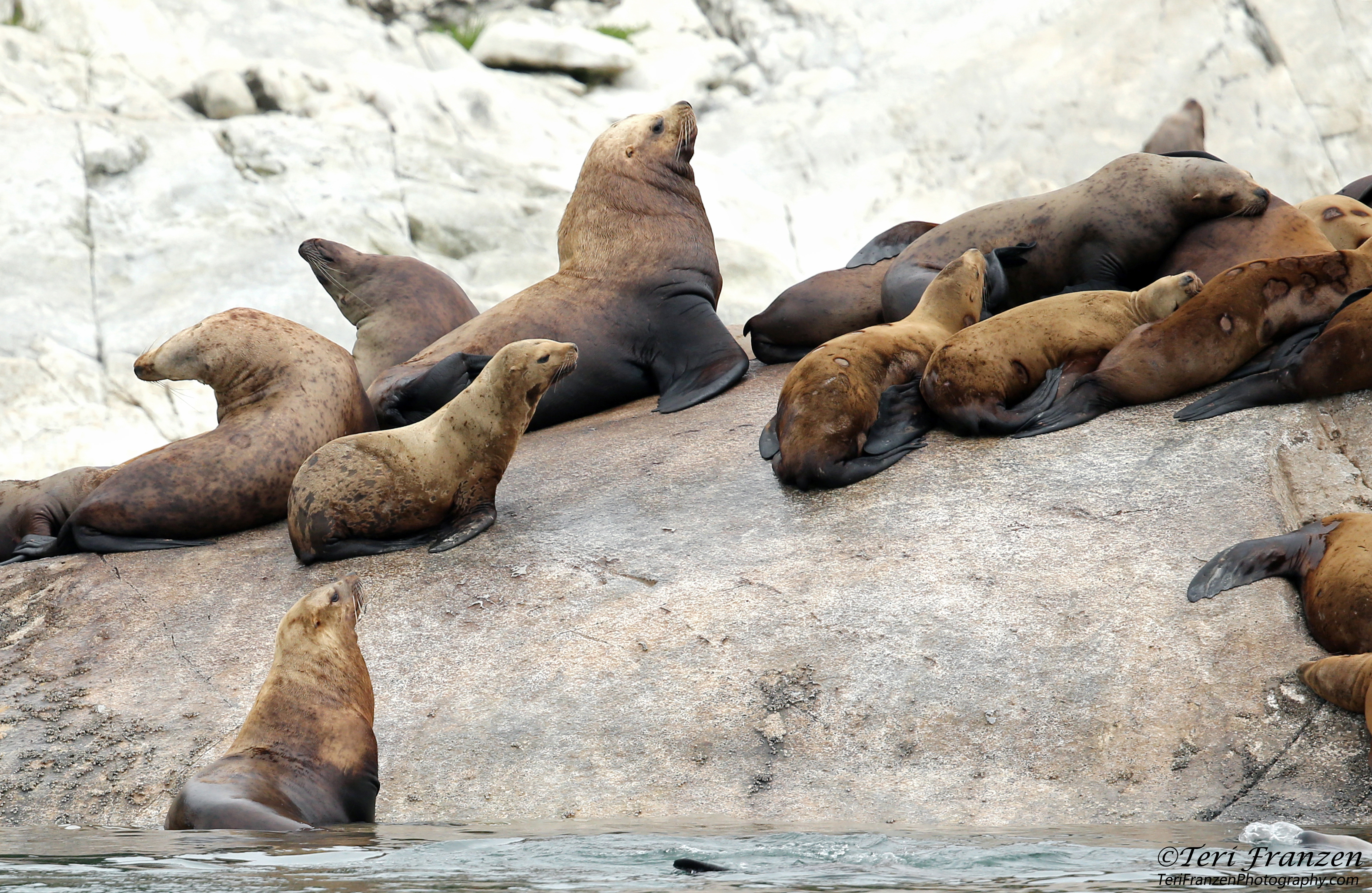
Sea Lions often sit with their noses in the air. Due to the position of their eyes they are able to view past their chins and look forward while in this position.
Different from a rookery, where marine mammals gather to reproduce, a haul-out is a gathering location where these animals leave the water between foraging periods. At this South Marble Island haul-out I noticed two Sea Lions that had branding marks, each starting with the letter W followed by a three-digit number. After a bit of internet research I have found that the letter indicates their birth rookery. These lions were born in the White Sisters rookery which is near White Sulphur Hot Springs on Chichagof Island of Glacier Bay.
I sent an e-mail with photos of each to the ADFG Marine Mammal Program and received more information about these two from Kelly Hastings. Both are females that were born in 2004. The first, W260, has been seen only at White Sisters and Marble Island. The second, W272, has been a little more adventurous and found at the same two locations as well as Gran Point near Haines and Benjamin Island near Juneau. Both females have been raising pups since they were five years old.
I was glad to learn that prior to branding the pups are anesthetized. The use use of heat, rather than cold, has been found to be the least intrusive method because it is quick and there have been no observed adverse affects to the animals. According to Kelly, this marking allows them to learn invaluable information about “…the life history of these animals: such as their survival and reproductive rates, and patterns of movement over their lifetimes.” This enables them to study the overall health and population trends of this species that, while it has rebounded in Glacier Bay, is still endangered in the western part of its range.

Large bull Sea Lion accompanied by females and pups, including 12-year old W260

Large bull on his way to take a dip in the water. Sea Lion W272 is currently nursing a pup.
I spent several minutes lost in a world of sea lions when a voice filled the air jolting me back into the boat. Captain Dan had called over the loudspeaker to ask if we should motor around the island. I was enjoying the current spot so much I nearly said no. But I gave him the thumbs up and we started moving. It took no time at all to learn what a mistake it would have been if we had stayed in one spot.
I continued to watch the shore as we started our cruise when I heard another voice, this time first mate Jason announcing “Puffins ahead!” It hit me then that not only did I have the beautiful Snow Goose and its amazing crew leading me on my very own private island tour, they were also helping me to spot wildlife!
Below is my favorite Puffin image thanks to the Dan, Jason and the Snow Goose.
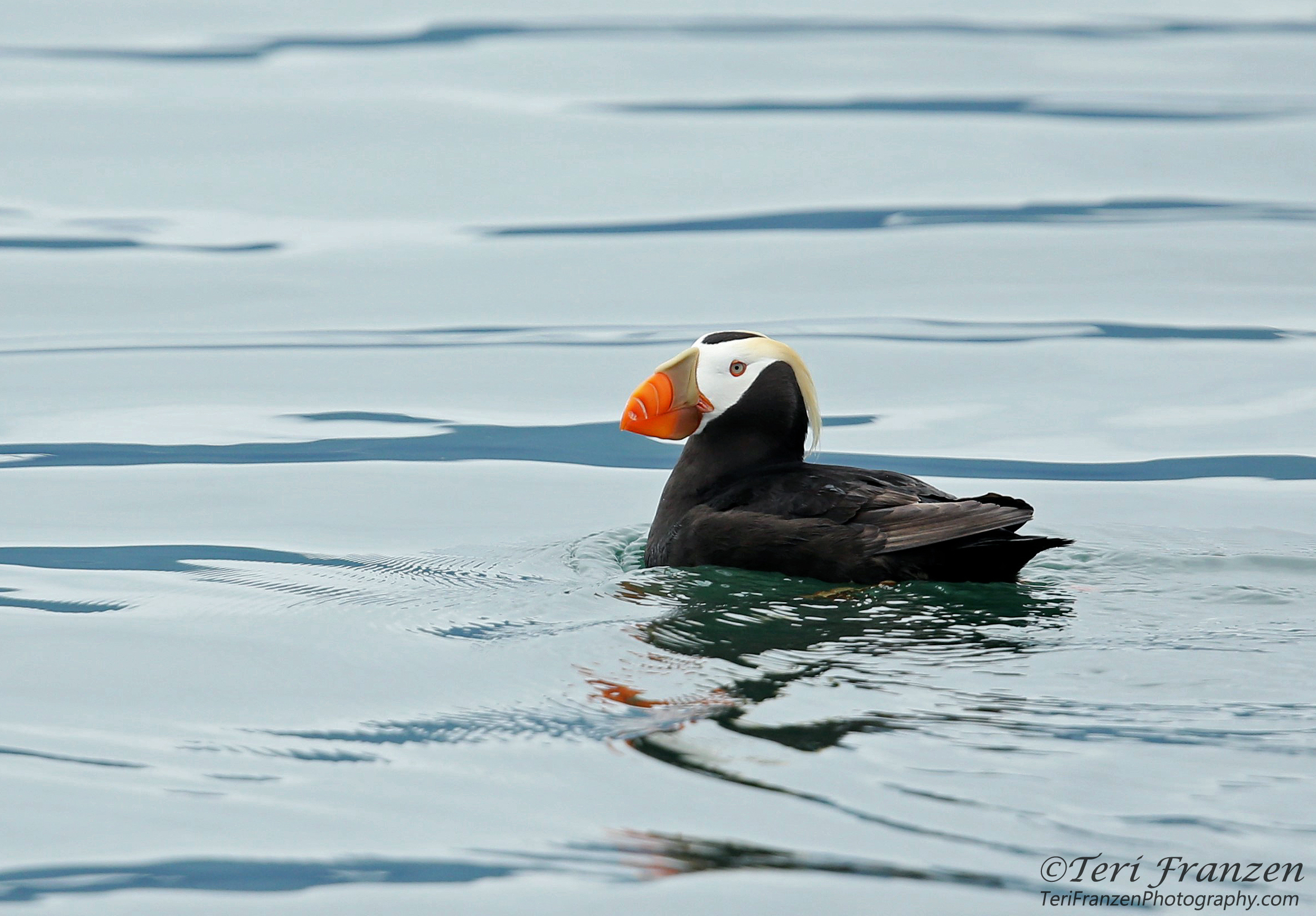
Tufted Puffin (Fratercula cirrhata)
Tufted puffins are the largest of the three Puffin species. They nest on South Marble Island, digging burrows one or more feet deep to lay their eggs. Also divers, these birds use their wings to basically fly under water chasing after fish, invertebrates and squid.

Puffins hunt for small fish until they fill their sizeable beaks before returning to the nest to feed their young

Tufted Puffin flapping its wings to clear excess water
As we continued further we encountered a flock of Pigeon Guillemots that flew in and landed on the limestone surface. These members of the auk family nest in colonies on rocky coastlines of the the Pacific. According to Audubon their conservation status is considered “climate threatened”. They are vulnerable to oil spills long after the immediate threat has dissipated and gillnet bycatch mortality accounts for a significant number of deaths. There is also a growing concern for this species due to shifting ecology caused by climate change. Breeding attempts can fail during years of unusually warm weather. And changes in marine ecosystems affect food availability. It was a great privilege to watch this group flocking onto the island.

Pigeon Guillemots flocking toward South Marble Island

Colony of Pigeon Guillemots as they landed on the island

Pigeon Guillemots will perch anywhere they can find a small ledge. They flap their wings to aid in climbing up the side of a hill.
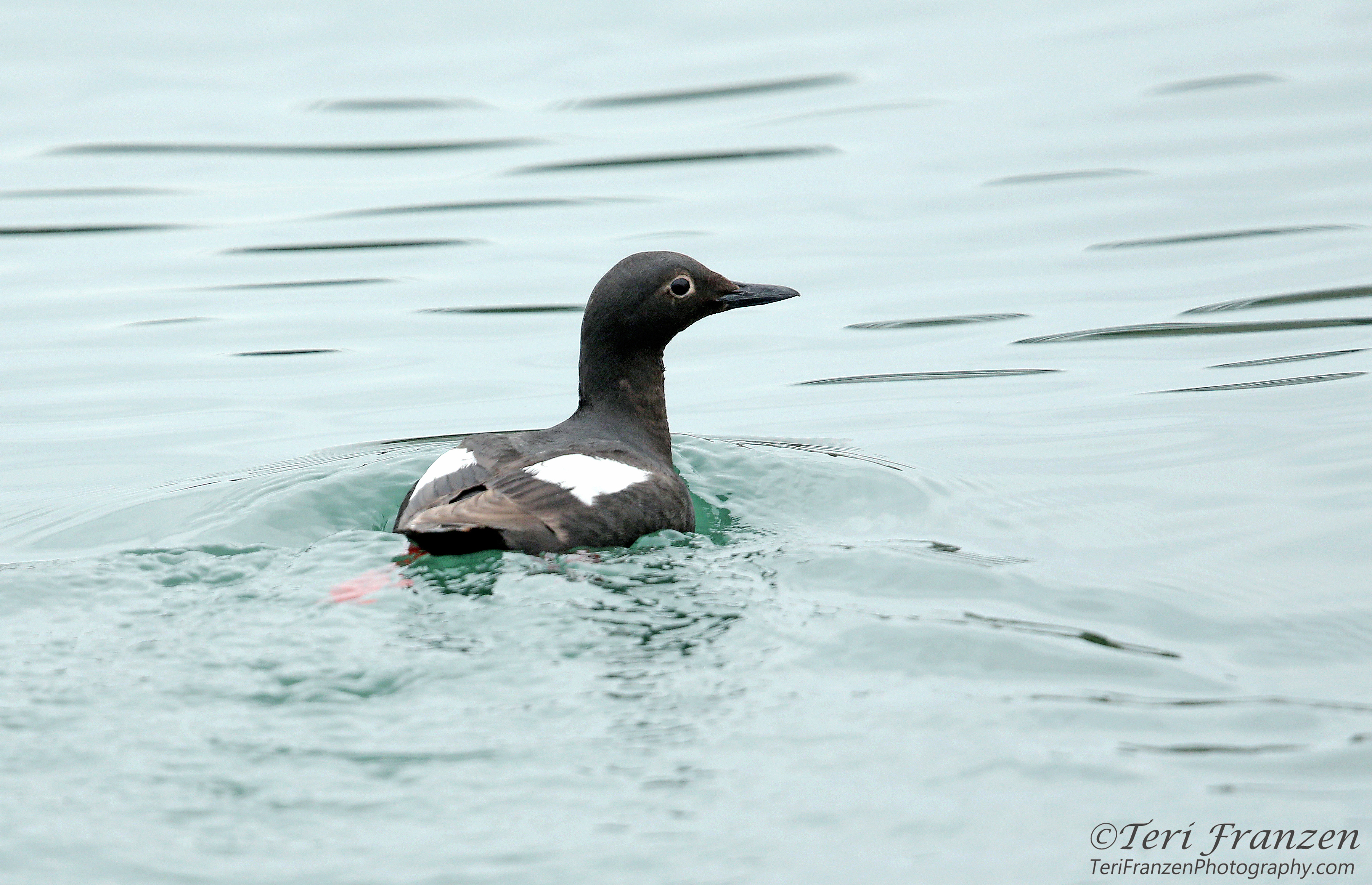
Pigeon Guillemot (Cepphus columba)
There were several Pelagic Cormorants on the island and we often saw them flying by in small groups and close to the water. They can be found all year along the northern Pacific coastline. These divers can reach distances of 150 feet below the water in the hunt for food. When the sun is shining their feathers will show a beautiful iridescence. Unfortunately the overcast skies didn’t allow me to see or photograph that feature.
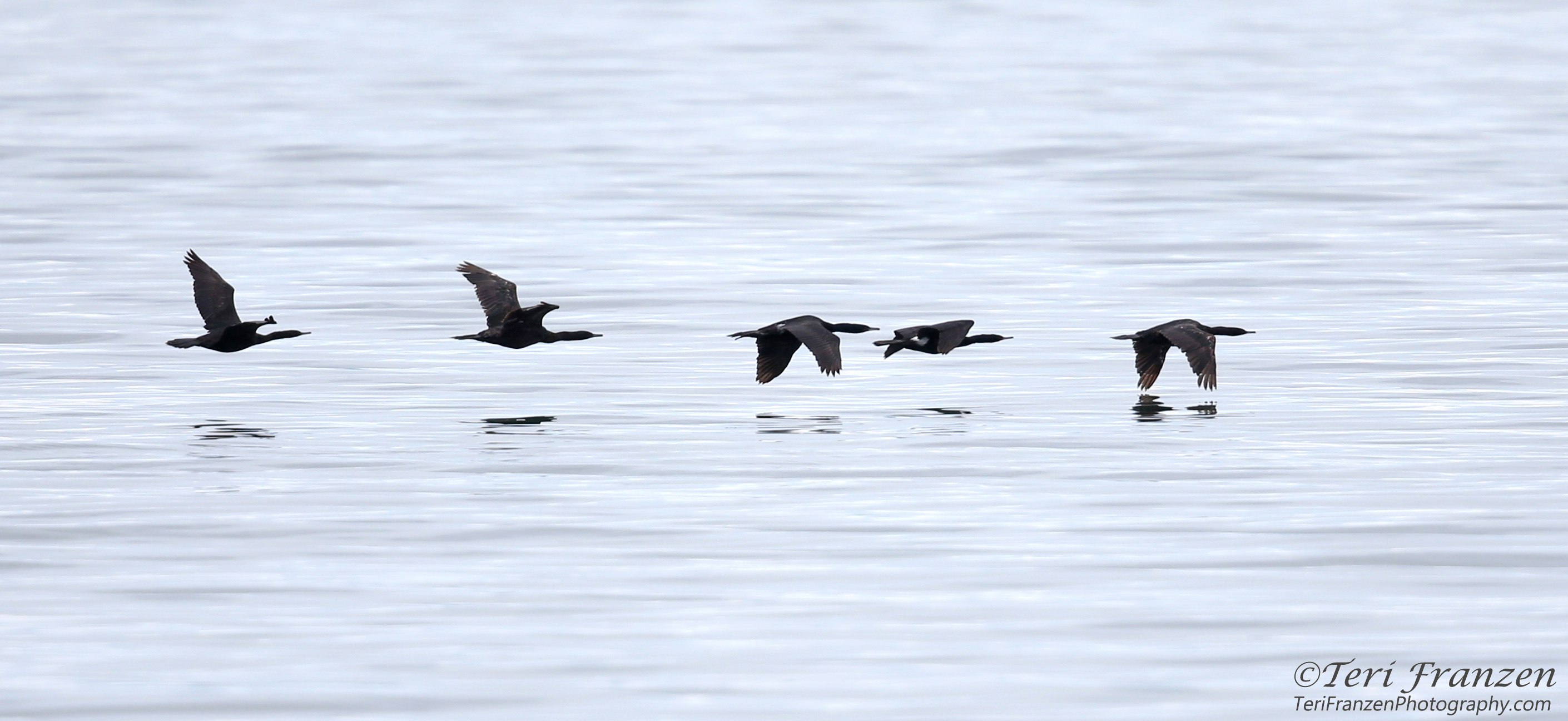
Pelagic Cormorants would often fly in single file and close to the water’s surface
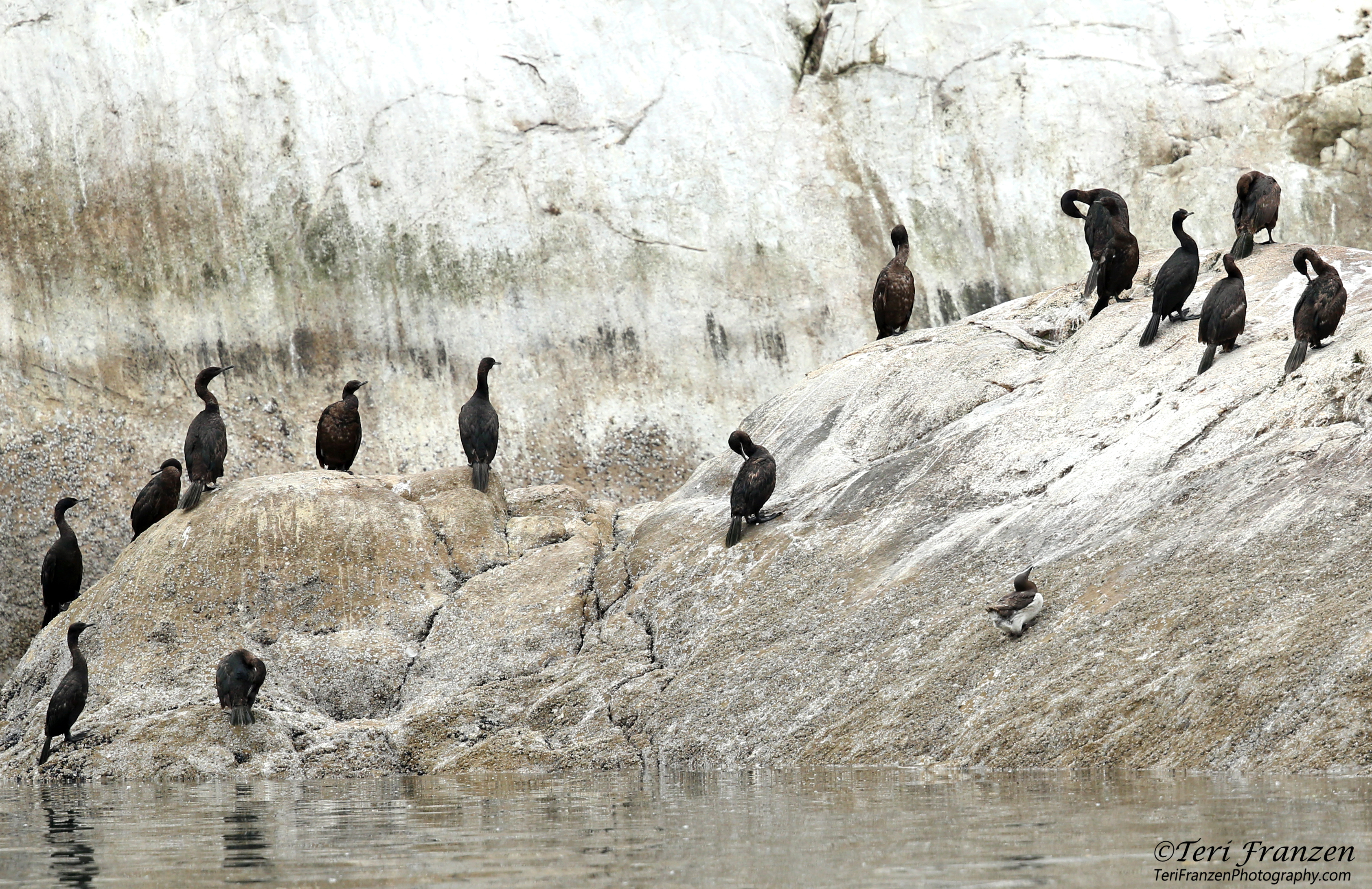
Pelagic Cormorants (Phalacrocorax pelagicus) and a lone Common Murre (Uria aalge) perched on the limestone surface of South Marble Island.
The most common large gull along the north Pacific coast, the Glaucous-winged gull, also nests on South Marble Island. For many generations the Huna Tlingit indians came to this location for a yearly spring egg harvest. This tradition marked the transition from scarcity into abundance between winter and spring. And it provided families with a cross-generation educational and bonding experience. Gull egg harvesting was suspended in the 1960s with the Migratory Bird Treaty Act and National Park Service regulations. However, after two decades of research the activity has been deemed non-intrusive to the species. Studies have shown that if an egg is removed from a nest before the clutch is complete (containing three eggs) a gull will produce a new egg to fill the gap. There has been a ruling that the Tlingit family tradition will be restored but I was unable to learn if they would return to South Marble Island.
When you find a group of gulls it is not uncommon to catch them posturing or fighting. That appears to have been the case with these two below engaged in a scuffle. Two gulls on the right appear to be egging them on while Kittiwakes watched from below.

Glaucous-winged Gull biting its adversary

Gulls prefer the limestone rock surface over perching in grassy fields
Black-legged Kittiwakes were also abundant on the island. These small gulls are very gregarious, often nesting in impressively large colonies. When they are on land you can hear their constant nasally call of “kit-ti-wake”. They nest in small mounds of mud and vegetation on shallow cliff ledges.
The scientific name for Kittiwake is tridactyla, meaning three-toed. This is because their hind toe is reduced to a small nub.

Black-legged Kittiwakes (Rissa tridactyla) nest on precariously shallow ledges

Black-legged Kittiwakes have beautifully shaped wings
When Ranger Tom VandenBerg was asked to identify his favorite spots in Glacier Bay he talked about South Marble Island because “It represents to me the incredible richness of life at Glacier Bay…a land that was covered by a massive glacier only 250 years ago, now filled with wildlife.” My trip around the island in July was nothing short of magical. Through my photos and research in the past couple of weeks I have relived that experience countless times. And I have learned so much more than I ever imagined, yet I know that I’ve only touched the surface. I hope to return one day when I can spend more time studying this beautiful island along with its unique array of inhabitants.

Sea Lions, Pelagic Cormorants, Glaucous-winged Gulls and Black-legged Kittiwakes are just a few of the species co-existing peacefully on South Marble Island

Steller bull preparing to dive

Final splash. Sea Lions can dive down to several hundred feet in their search for food.

Life on the rock
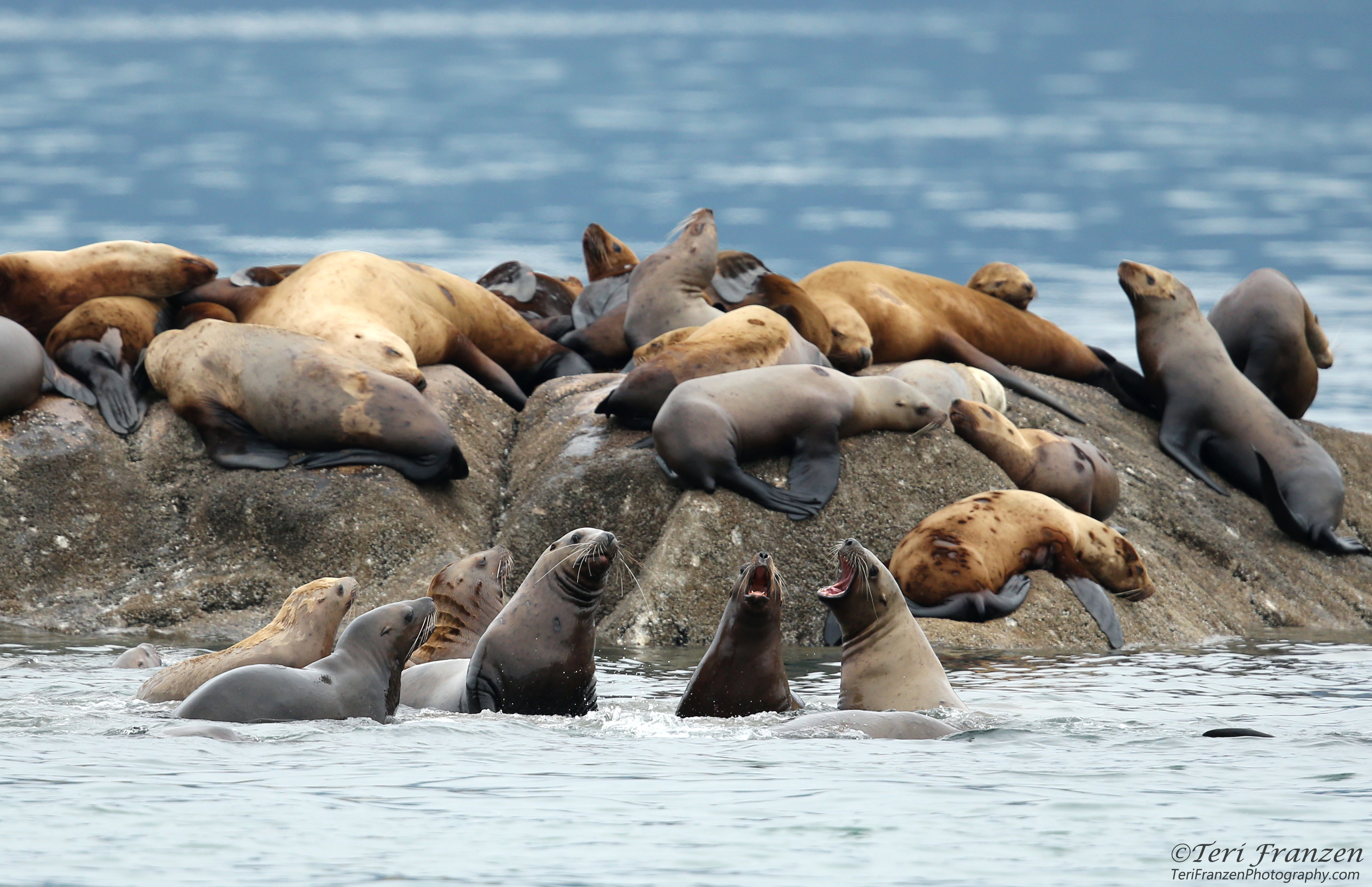
Sea Lion Council

Pelagic Cormorants and roosting Black Oystercatchers

South Marble Island

Kayakers returning from their adventure around the island

Captain Dan on upper deck. Jason was in the wheel house.

